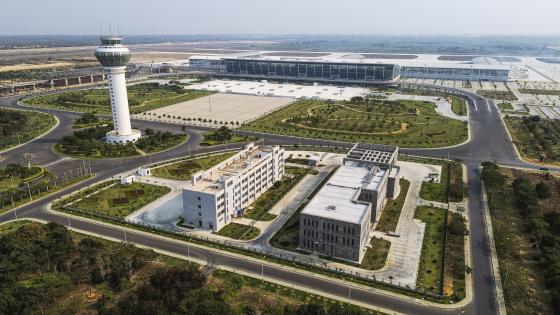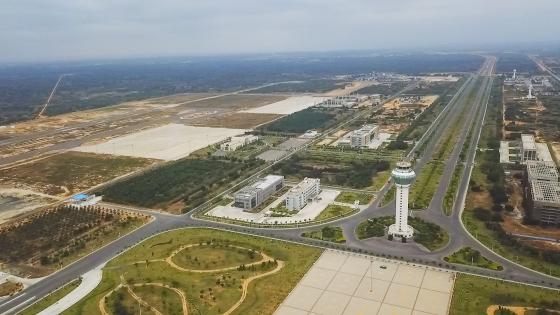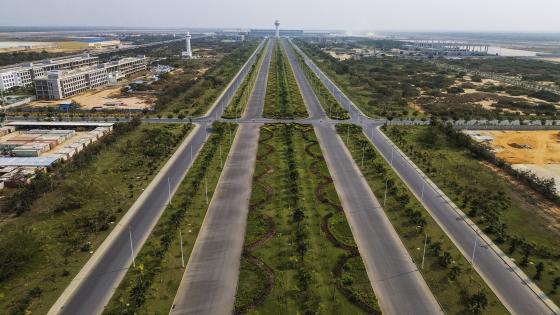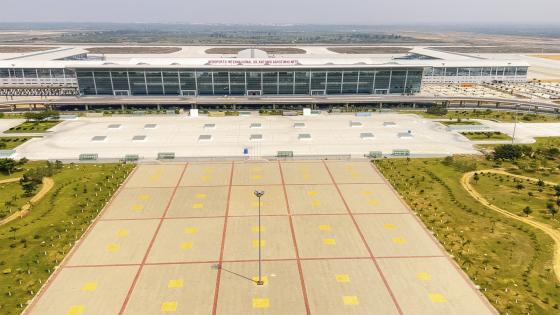Ricardo Viegas D’Abreu, Minister for Transport, Angola, is responsible for the African country’s new international airport, a monumental hub scheduled to open this year. Tara Craig asked him about the project.
Does Angola need this airport?
During the COVID-19 pandemic, Angola was the African country with the longest air traffic restrictions. We are recovering and now have more airlines connecting to Luanda, more flights, more people moving in and out of the country. Domestic flights are already 20% over our 2019 numbers and the existing airport would not be fit for the reform agenda and growth planned for aviation in Angola. The idea is to have a facility – the Dr António Agostinho Neto International Airport – that will support the Angolan government in its bid to diversify from our traditionally oil-centric economy. Civil aviation will be instrumental in driving a new focus on tourism, the export of agricultural and industrial products and the creation of a huge logistics base. We want the new airport to stimulate opportunities for local small and medium businesses in transport and tourism. We are also looking for ways to incentivise gender equity, which is a big issue in our society. We plan to complete construction by the end of October 2023 and inaugurate the airport shortly afterwards.

Ricardo Viegas D’Abreu has been Angola’s Minister for Transport since 2018
How much will it cost?
We expect to spend around $3bn for the airport and supporting infrastructure, including a fuel farm, cargo terminal and administrative buildings. We are also developing a new Airport City on a 110km² space nearby. The airport has been fully funded by the government of Angola and the idea is that the businesses operating in Airport City will enable it to recoup its investment. We will soon start engaging with the private sector in a public private partnership to continue developing the opportunities around the airport.
The project is much delayed: why?
Initially, it was privately funded but the investors were unable to fulfil the project and the government decided to complete it using public funds. We were also forced to change contractors. The new contractors [AVIC – the Aviation Industry Corporation of China, a Chinese state-owned aerospace and defence conglomerate] will complete the build. This is the largest single airport built by any Chinese company around the globe as a single infrastructure.

Air traffic control will be among the systems addressed as part of Angolan aviation’s digital transformation
Who will operate the airport?
We are finalising preparations for the launch of an international tender for the airport concession. We have received several letters of intent from global companies keen to bid. We will have a decision about the final operator in the first quarter of 2024. A temporary operator is responsible for the ORAT [Operational Readiness and Airport Transfer] activities and will run the airport until the final operator takes over.
According to our feasibility studies, expansion will be necessary ten to 15 years after the airport opens. Space is already set aside for expansion.
What technology will the new airport feature?
As part of a review of the legal, regulatory and institutional framework of the transportation sector, we established ANAC [Autoridade Nacional da Aviação Civil], the civil aviation authority of Angola. Last December we were audited by ICAO [The International Civil Aviation Organization] for the safety and security of our civil aviation operational systems. We performed really well, above average for the [African] continent and very close to global standards.
Cargo is critical today in global aviation and we want to be part of that

Angola’s Ministry of Transport is finalising preparations for the launch of an international tender for the airport concession
In terms of new technology, there are two important elements at play. The first is the modernisation of the civil aviation system, including its digital transformation. This infrastructure that we are putting together is helping transform the Angolan civil aviation system, not only the processing of passengers and cargo, but also support systems for air traffic control (ATC), navigation and radar, among other things. We are working with ICAO to develop a modern training centre for navigation and ATC systems.
The second element is sustainability. The new airport will have its own fuel farm, producing sustainable aviation fuels. We also want it to be a certified Green Airport and we are addressing elements such as the energy supply to the terminal and various systems and equipment. We are looking at water usage and waste water management systems so we can have a circular water economy, and we will have two energy sources for the airport. The first is a solar park and the second is a hydro power facility. We are considering an alternative back-up solution – a gas facility.
What are you planning to do with the existing airport?
Quatro de Fevereiro International Airport will remain in operation, but involving a different type of aviation. It will continue to serve Luanda, which has 12 million inhabitants today and is expected to reach 15 million by 2030. We think it makes sense to have the city airport and also an international airport. We will specify the types of connectivity for the existing airport so as to avoid any impact on the new airport’s revenue stream. We expect it to be used for VIPs, business aviation and charter flights, possibly even for maintenance and training. A similar set-up can be seen in Johannesburg, with Lanseria Airport and O R Tambo Airport.
Close to 70% of the African market is operated by non-African airlines, so we need to grow African connectivity

The government of Angola has invested $3bn in the new airport, to include a fuel farm and administrative and cargo areas
What routes will the new airport serve?
In terms of cargo operations, our national carrier – TAAG Angola Airlines – began operations between Latin America and China last year and will support our plans to be a hub for South America-Asia traffic. Several important international cargo and logistics players already operate here and are committed to the new infrastructure. We have a 50,000 tonnes area for cargo storage and management at the new airport, but we are already asking ourselves how long this will meet demand. Close to the airport, on the land side, we are developing a 120ha logistics park that will support cargo activity. Cargo is critical today in global aviation and we want to be part of that.
On the passenger side, our pre-COVID-19 connection to Beijing will resume shortly, but we are also targeting European, Latin American and North American passengers as well as those on the [African] continent. We want to develop a regional passenger hub. Close to 70% of the African market is operated by non-African airlines, so we need to grow African connectivity. That’s why the combination of the right regulatory and institutional framework, and the right infrastructure and carrier, is critical.

The new airport will initially handle 15 million passengers a year, two-thirds of them international travellers
How does the airport connect with the national transport network?
We have developed an Accessibility Plan for the new airport, covering road and rail infrastructure, including the light railway. By September/October this year, we will have a railway connection to the new airport from downtown Luanda. We are building four new stations along the line, and the new airport will connect to the existing North Corridor railway line. That means that visitors to Angola can easily reach Malanje Province, which is home to the Calandula Falls, one of our seven wonders. The country has tremendous potential as a tourism destination. We can offer not just sun and beaches, but also safaris and sightseeing – and we will have the air transport infrastructure to support it. We are also addressing visa facilitation, making access to Angola much easier. All our railway lines are connected to ports, so there is potential to attract major cruises. In terms of tourism, the connectivity is in place. Now we need to market Angola as a destination.
Airports are the first door that people see when they come to a country. What we have to say is that our future is now and the door – the Dr António Agostinho Neto International Airport – is open.
Need to know more: The numbers
Cost: $3bn
Annual capacity: 15 million
· 10 million international passengers
· 5 million domestic passengers
Passengers per peak hour: 4,932
Two runways
· North Runway 4E: 3,800m
· South Runway 4F: 4,000m
Jet bridges: 31
Check-in counters: 94
Baggage conveyor belts: 9
Parking spaces: 1,710
